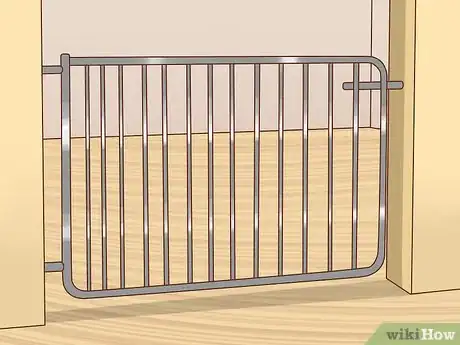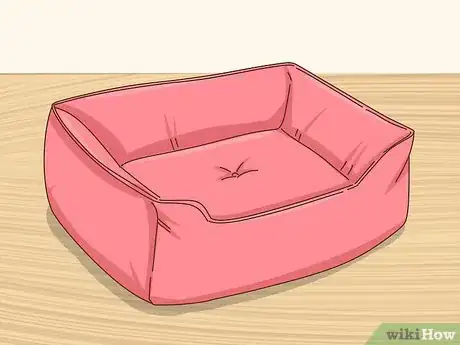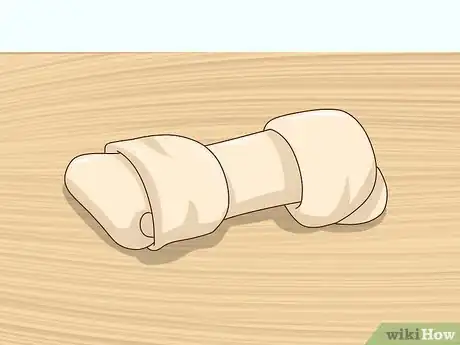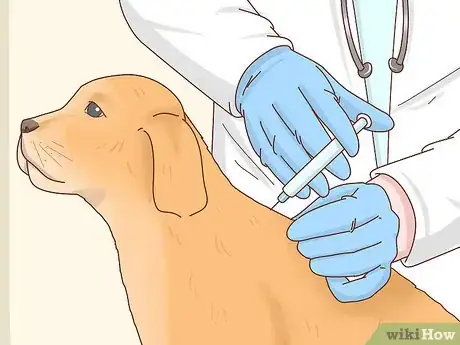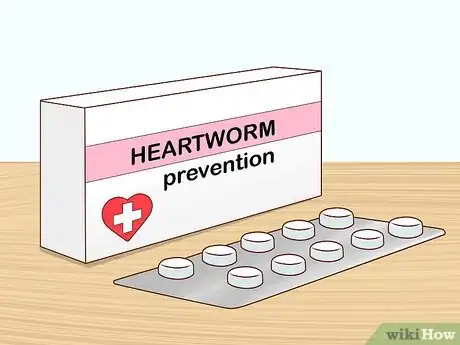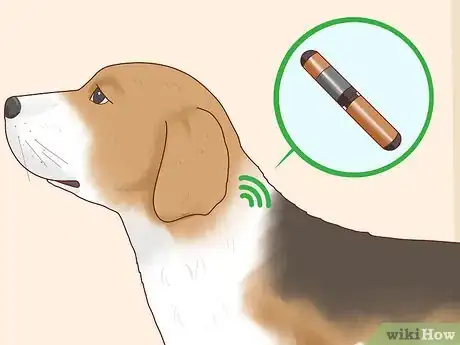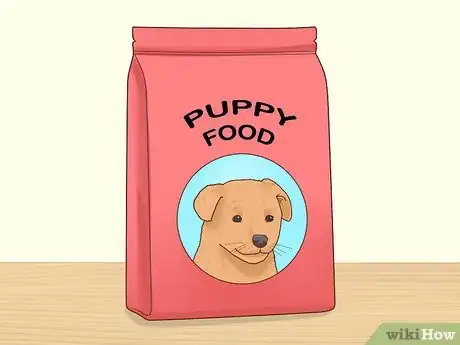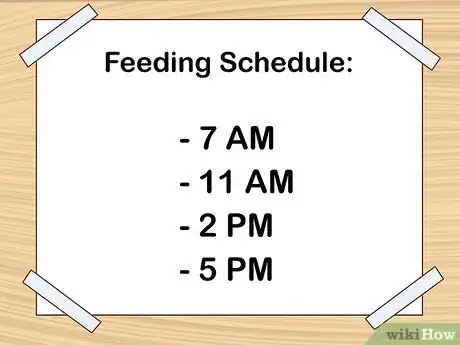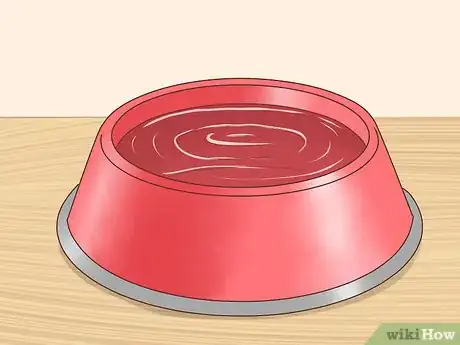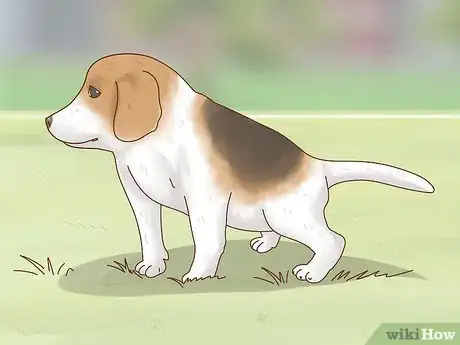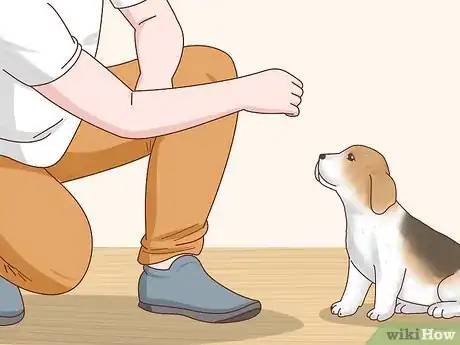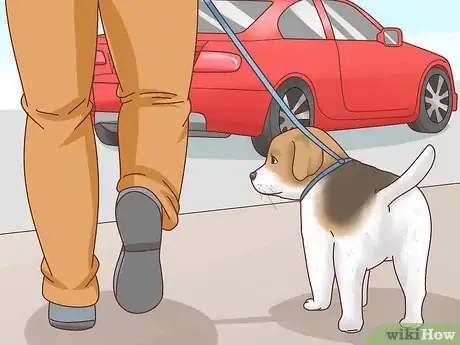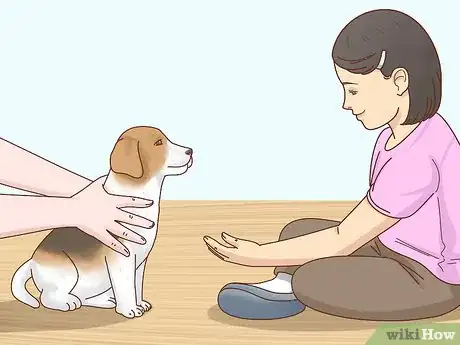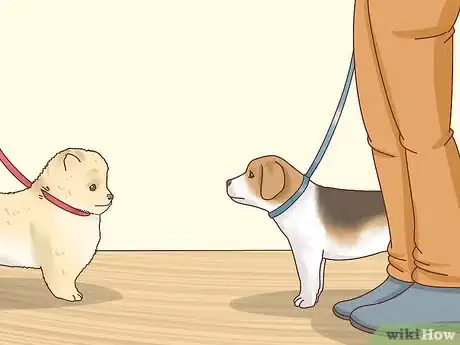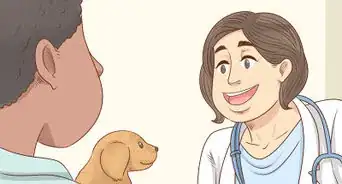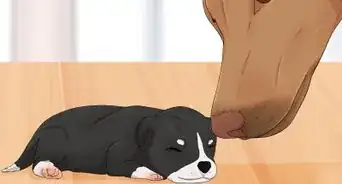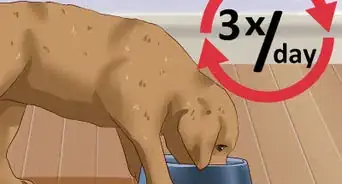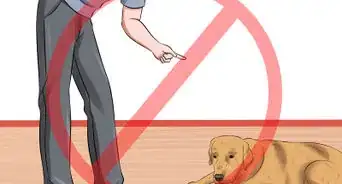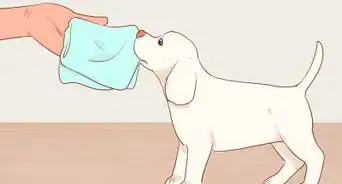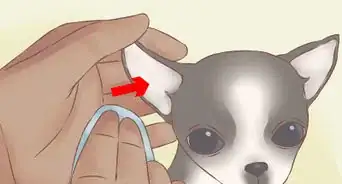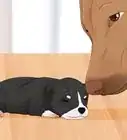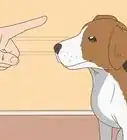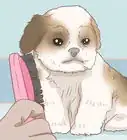This article was co-authored by Beverly Ulbrich. Beverly Ulbrich is a Dog Behaviorist and Trainer and the Founder of The Pooch Coach, a private dog training business based in the San Francisco Bay Area. She is a Certified CGC (Canine Good Citizen) Evaluator by the American Kennel Club and has served on the Board of Directors for the American Humane Association and Rocket Dog Rescue. She has been voted the best private dog trainer in the San Francisco Bay Area 4 times by SF Chronicle and by Bay Woof, and she has won 4 "Top Dog Blog" awards. She has also been featured on TV as a dog behavior expert. Beverly has over 18 years of dog behavior training experience and specializes in dog aggression and anxiety training. She has a Master of Business Administration from Santa Clara University and a BS from Rutgers University.
There are 7 references cited in this article, which can be found at the bottom of the page.
wikiHow marks an article as reader-approved once it receives enough positive feedback. In this case, 99% of readers who voted found the article helpful, earning it our reader-approved status.
This article has been viewed 252,908 times.
At 8 weeks of age, your puppy is ready to leave its mother and littermates, and join your family. Your focus should be on your puppy’s basic needs of eating, drinking, sleeping, playing, and eliminating. Around this time, a puppy is also becoming more curious and interested in its environment, so this is the best time to start teaching your puppy everything it needs to know!
Steps
Basic Care
-
1Puppy proof your home before you bring the puppy home. Your puppy will try to get into things it shouldn’t. Telling your puppy “no” will not be effective this early, and it will be impossible for you to watch your puppy all of the time. Ensure that your home is free from hazards to your puppy before you bring it home. Some effective ways to puppy proof your home include:[1]
- Placing cleaning agents and other chemical bottles on a high shelf or in a locked cupboard.
- Putting up small hazards, such as coins, paperclips, pins, marbles, and rubber bands.
- Using baby gates to block off rooms and areas that you do not want your puppy to enter.
-
2Get a bed for your puppy. Your puppy will need a cozy place to sleep at night. Make sure to get your puppy a bed that is big enough for it to fit on now and as it grows, such as a bed that is 4 by 4 ft (1.2 by 1.2 m) or larger for a big dog. Place the bed in a draft-free place in your home to ensure that your puppy will be warm in its new bed. You can also put the bed in a kennel, just be sure to measure the kennel so the bed will fit. [2]
- If you do not want to purchase a bed, then designate a few blankets as your puppy’s bed. Fold and stack them to make a soft place for your puppy to sleep.
Tip: You can place your puppy's bed in a kennel if you decide to get one. The kennel will also serve as your puppy's den, which may be comforting to it. Get a kennel that is large enough for your puppy to stand up, lay down, and turn around.
Advertisement -
3Select appropriate chew toys for your puppy. Puppies still have their baby teeth at 8 weeks. As they lose these and grow their adult teeth they’ll need to chew. Make sure your puppy always has plenty of simple toys and size appropriate rawhide bones. Have some in every room your puppy is allowed to be in.[3]
- If your puppy chews the wrong thing, pick up its toy or bone, go to it and take away what it has with a stern “No” and then give your puppy its toy or bone. When it starts chewing the toy, give it praise.
- If you don’t give your puppy something to chew, it will find something to chew. Puppies need to chew to help relieve their teething pain.
-
4Make an appointment for vaccinations and deworming. Your puppy will need to be vaccinated once every 2 to 3 weeks until it is 4 months old and it will also need deworming treatments during this time. Call your local veterinarian and arrange an appointment for your puppy for soon after you take the puppy home.[4]
- Good breeders begin vaccinations very early before the pup is ready to come home with you. Ask your breeder for its puppy vaccination records so you can give it to your vet. If you are adopting the puppy from a shelter, its early vaccinations should also already be taken care of, but make sure to ask!
- Puppies are often born with worms and may need to be dewormed by your vet. The breeder or shelter should have already done this, but ask to be sure.
-
5Get heartworm prevention medication for your puppy. Heartworm prevention is important to puppies and dogs of all ages and should be started when they are young. Make an appointment with your vet to get your puppy its heartworm medication. Dogs of any age can get heartworm from a mosquito bite, and heartworm may kill your dog once they get it, so prevention is key![5]
- Heartworm can be treated, but treatment is very expensive and the treatment itself kills the dog in about half the cases.
-
6Microchip your puppy in case it gets lost. Even if your puppy has a tag, it could get lost. Ask your puppy’s veterinarian about having a microchip implanted in your puppy. This way, if your puppy gets lost and taken in by a shelter, they will be able to contact you using the information in the microchip.[6]
- Keep in mind that a microchip does not work like a GPS device. It only serves as a way to identify your pet if it gets taken to a shelter.
- Some countries, such as the United Kingdom, legally require dogs to be chipped by 8 weeks of age. Check with your country’s laws and regulations to see if microchipping is required.
Feeding
-
1Purchase dog food that is specifically formulated for puppies. Puppies cannot eat regular dog food. They need to have a food that is meant for puppies. This type of food will provide your puppy with the nutrients it needs to grow and it is in smaller pieces that are easier for your puppy to chew. Purchase a bag before you bring the puppy home.[7]
- Ask your veterinarian or the breeder or shelter for a recommendation if you are unsure about which type of puppy food to buy.
-
2Feed your puppy 4 scheduled meals per day. 8-week old puppies need to eat frequently to get in enough calories. Until your puppy is 12 weeks old, it will need to be fed 4 times daily at regular intervals. Develop a feeding schedule for your puppy to ensure that it gets the nutrition it needs.[8]
- For example, you could feed your puppy at 7 AM, 11 AM, 2 PM, and 5 PM.
- Continue feeding this way until your puppy reaches 14 weeks, and then switch to 2 feedings per day.
-
3Provide your puppy with fresh, clean water at all times. It is important for your puppy to stay hydrated, and puppies drink a lot of water! Your puppy may drink as much as ½ cup (120 mL) of water every 2 hours. Always keep a bowl of fresh, clean water out for your puppy. Place the bowl somewhere that will be easy for your puppy to access and check the bowl a few times daily.[9]
- For example, try placing the bowl in the corner of the room where the puppy spends the most time.
- If you take your puppy outside to play, bring a bowl of water outside too.
Tip: It is also okay to offer treats to your puppy occasionally as a reward for good behavior. However, make sure to limit these to avoid making your puppy overweight!
Training and Socializing
-
1Take your puppy outside regularly to eliminate in the same place. House training a puppy requires consistency. Your puppy will need to go to the bathroom frequently since puppies cannot hold their urine or feces for very long. Take your puppy to the same spot every time to help it associate the spot with eliminating. Take your puppy out to go potty at the following times:[10]
- When it wakes up in the morning
- After it eats
- When it wakes up from a nap
- After it has just finished playing
- Before bedtime
- Every 20-30 minutes when its awake
Tip: Crate-training with a kennel is also an effective way to housetrain your puppy, and to keep your puppy safe when you have to leave for a couple of hours.
-
2Teach your puppy basic commands. At 8 weeks, your puppy will be ready to learn new things. This is a great time to teach it some basic commands, such as sit, stay, and lay down. Use positive reinforcement to teach your puppy these commands, such as by praising your puppy or offering it a treat when it does the desired behavior. You may train your puppy on your own, or complete a training course with your puppy.[11]
- For example, if you are trying to teach a puppy to sit, use a treat as a lure and hold it up in the air to get your puppy to look up at it. When your puppy’s butt hits the ground, praise and pet your puppy and give it the treat. Then, repeat the activity while saying “sit” as you hold the lure. After a few sessions, your puppy will begin to understand that “sit” means to sit and that it will get praise by doing this.
-
3Introduce your puppy to lots of different sights and sounds. Puppies need to be exposed to lots of different sights and sounds to ensure that they will not be fearful of those things later on. Carry your puppy outside when you introduce it to new sights and sounds. Make sure to keep it on a leash as well so it can explore safely if you set it down.[12]
- The breeder or shelter should have already started socializing your puppy by handling, exposure to different smells, and toys. Ask the breeder or shelter how they started socializing the puppy so you will know what types of exposure the puppy has already had.
EXPERT TIPBeverly Ulbrich is a Dog Behaviorist and Trainer and the Founder of The Pooch Coach, a private dog training business based in the San Francisco Bay Area. She is a Certified CGC (Canine Good Citizen) Evaluator by the American Kennel Club and has served on the Board of Directors for the American Humane Association and Rocket Dog Rescue. She has been voted the best private dog trainer in the San Francisco Bay Area 4 times by SF Chronicle and by Bay Woof, and she has won 4 "Top Dog Blog" awards. She has also been featured on TV as a dog behavior expert. Beverly has over 18 years of dog behavior training experience and specializes in dog aggression and anxiety training. She has a Master of Business Administration from Santa Clara University and a BS from Rutgers University.Dog Behaviorist & Trainer
 Beverly Ulbrich
Beverly Ulbrich
Dog Behaviorist & TrainerOur Expert Agrees: Socialization is very important to young puppies, so take them to the dog park or on walks outside as often as you can. By the time your dog is 12 weeks old, they should have met around 100 different people to ensure they're properly adjusted to being out in the world.
-
4Provide lots of opportunities for your puppy to interact with people. Make sure your puppy has many positive experiences with people from all walks of life. This will help to ensure that your puppy does not develop a fear or dislike of certain people, such as children, men, or tall people. Invite friends over and take your puppy out where it can interact with different people, such as on a walk in the park.[13]
- Everything your puppy experiences during this time will be forever imprinted in him. For example, if a man with a beard does something to frighten your puppy, this is not a positive experience. Expose the puppy to bearded men who provide a positive experience so it doesn’t grow into a dog who is fearful of, or aggressive toward, men with beards.
-
5Expose your puppy to other dogs in a safe, controlled environment. Being around other dogs is also important for socializing your puppy. Take your puppy to a puppy training program so that you can expose it to other dogs in a safe, controlled environment. Check with your local pet store or dog kennel for information on the puppy training programs.[14]
- Make sure that you only allow the puppy around other animals that have been vaccinated.
Expert Q&A
-
QuestionMy 8-week old, who is a rescue, has terrible dandruff and itching. Any ideas on what we can use? (He's vaccinated but not as much as he will be over the next couple of weeks.)
 Pippa Elliott, MRCVSDr. Elliott, BVMS, MRCVS is a veterinarian with over 30 years of experience in veterinary surgery and companion animal practice. She graduated from the University of Glasgow in 1987 with a degree in veterinary medicine and surgery. She has worked at the same animal clinic in her hometown for over 20 years.
Pippa Elliott, MRCVSDr. Elliott, BVMS, MRCVS is a veterinarian with over 30 years of experience in veterinary surgery and companion animal practice. She graduated from the University of Glasgow in 1987 with a degree in veterinary medicine and surgery. She has worked at the same animal clinic in her hometown for over 20 years.
Veterinarian I would get the vet to check the puppy for cheyletiella, (a mite with the nickname "walking dandruff".) This mite looks like dandruff and causes extreme itchiness.
I would get the vet to check the puppy for cheyletiella, (a mite with the nickname "walking dandruff".) This mite looks like dandruff and causes extreme itchiness. -
QuestionShould I use one puppy pad for my puppy so that it's a dedicated spot for it to go?
 Pippa Elliott, MRCVSDr. Elliott, BVMS, MRCVS is a veterinarian with over 30 years of experience in veterinary surgery and companion animal practice. She graduated from the University of Glasgow in 1987 with a degree in veterinary medicine and surgery. She has worked at the same animal clinic in her hometown for over 20 years.
Pippa Elliott, MRCVSDr. Elliott, BVMS, MRCVS is a veterinarian with over 30 years of experience in veterinary surgery and companion animal practice. She graduated from the University of Glasgow in 1987 with a degree in veterinary medicine and surgery. She has worked at the same animal clinic in her hometown for over 20 years.
Veterinarian Ideally take the puppy outside to a toilet spot if this is where you want him to go. However, if you are in an apartment and going outside is difficult, then a puppy pad is fine.
Ideally take the puppy outside to a toilet spot if this is where you want him to go. However, if you are in an apartment and going outside is difficult, then a puppy pad is fine. -
QuestionWhat should an 8 week old puppy eat?
 Jason.KellyCommunity AnswerPuppy food that is high in protein. Depending on the breed, you can soften it in puppy milk. You should ask your veterinarian for specifics.
Jason.KellyCommunity AnswerPuppy food that is high in protein. Depending on the breed, you can soften it in puppy milk. You should ask your veterinarian for specifics.
Warnings
- Before you get your puppy, know how big he’ll be as an adult and the typical personality of the breed. Be sure you can accommodate it for its whole life.⧼thumbs_response⧽
References
- ↑ https://www.akc.org/expert-advice/home-living/puppy-proofing-tips-for-your-home-and-yard/
- ↑ https://www.rspca.org.uk/adviceandwelfare/pets/dogs/puppycare
- ↑ https://www.rspca.org.uk/adviceandwelfare/pets/dogs/puppycare
- ↑ https://www.merckvetmanual.com/dog-owners/routine-care-and-breeding-of-dogs/puppy-care
- ↑ https://www.merckvetmanual.com/dog-owners/routine-care-and-breeding-of-dogs/puppy-care
- ↑ https://www.avma.org/KB/Resources/FAQs/Pages/Microchipping-of-animals-FAQ.aspx
- ↑ https://www.petmd.com/dog/puppycenter/nutrition/evr_dg_feeding_schedule_for_puppies
- ↑ https://www.merckvetmanual.com/dog-owners/routine-care-and-breeding-of-dogs/puppy-care
- ↑ https://www.akc.org/expert-advice/health/puppy-drinking-enough-water/
- ↑ https://www.merckvetmanual.com/dog-owners/routine-care-and-breeding-of-dogs/puppy-care
- ↑ https://www.merckvetmanual.com/dog-owners/routine-care-and-breeding-of-dogs/puppy-care
- ↑ https://www.merckvetmanual.com/dog-owners/routine-care-and-breeding-of-dogs/puppy-care
- ↑ https://www.vetwest.com.au/puppycare
- ↑ https://www.vetwest.com.au/puppycare
About This Article
To care for an 8-week old puppy, feed it dog food that's formulated for puppies 4 times a day, and make sure it has access to fresh drinking water at all times. You should also give your puppy plenty of chew toys since young puppies need things to chew on while their adult teeth grow in. Also, make an appointment with a vet to have your puppy vaccinated and dewormed and to get it heartworm medication. For more tips from our Veterinary co-author, like how to train and socialize an 8-week old puppy, read on!
